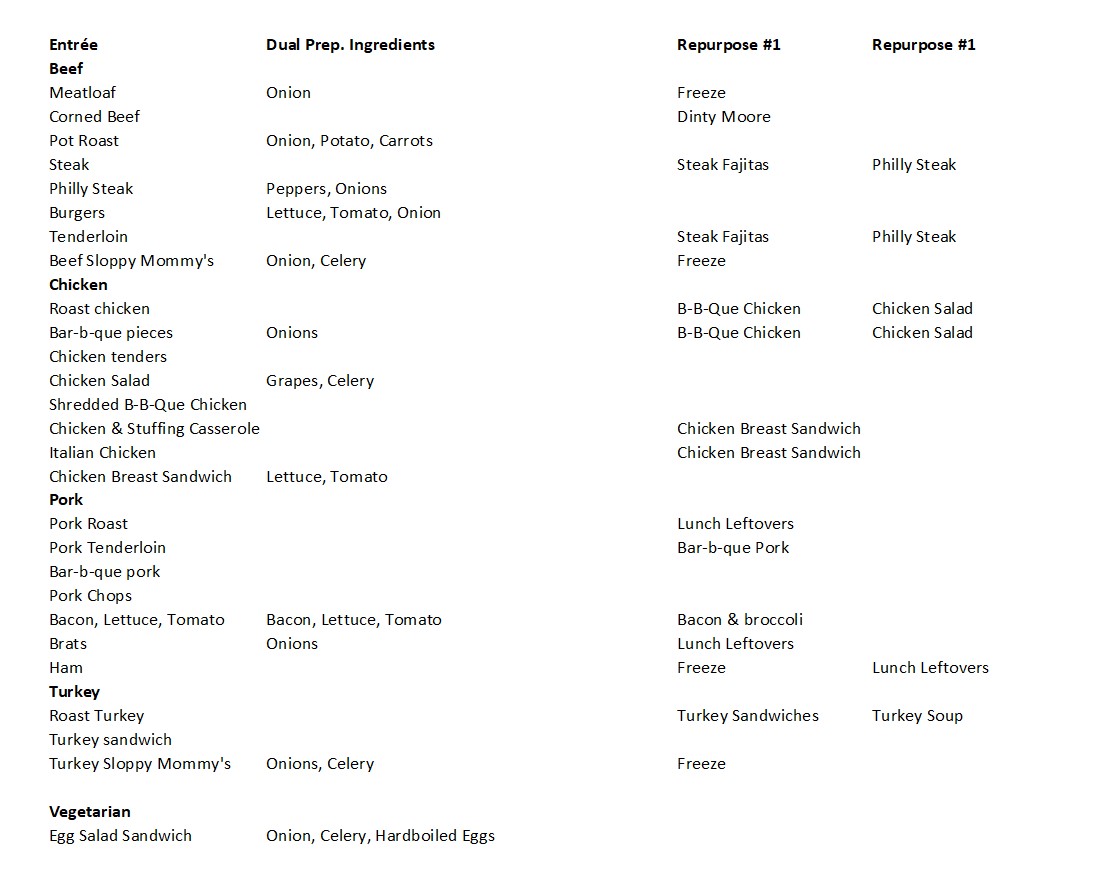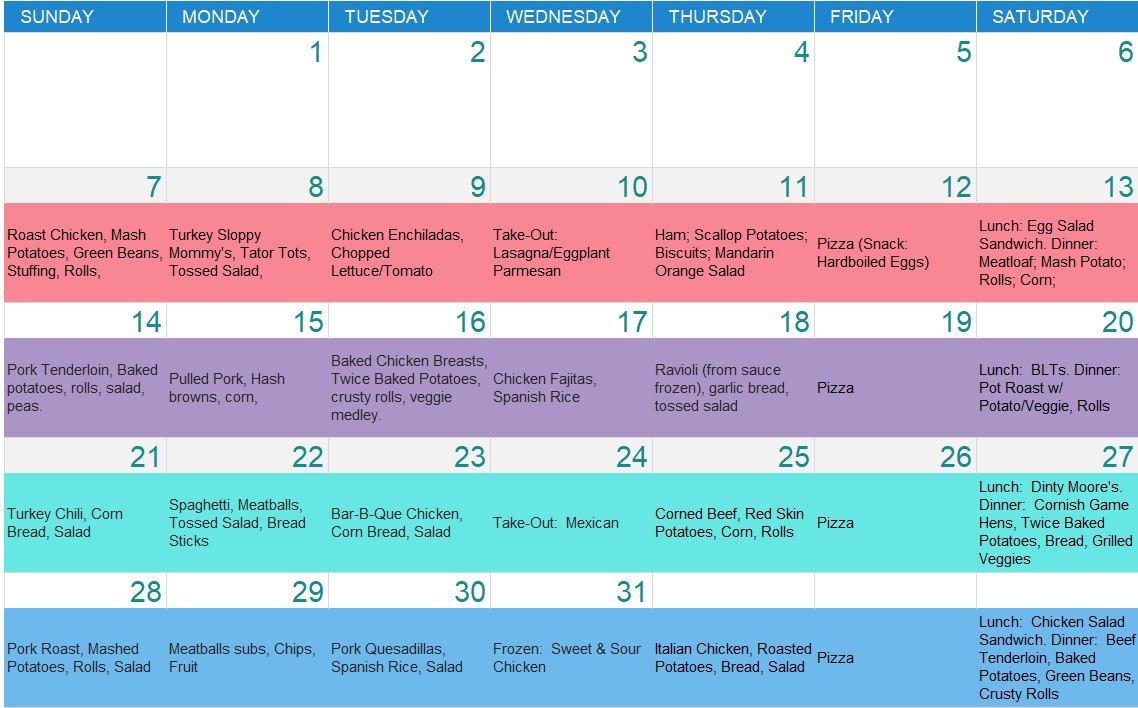
I detest three household chores: Unloading groceries, sterilizing medical equipment, and feeding the family. My Twitter feed suggests task number three proves the bane of many parents’ existence. But by following ten simple steps, 2018 can mark the year you make meals manageable.

Step 1: Change Your Thinking About Feeding Your Family
Stop thinking feeding your family means getting your family to eat. Before attacking the meal planning and prepping, dispel the notion that feeding your family means getting your family to eat. That’s not your job.
As dietitian and feeding expert Ellyn Setter explains in “Child of Mine” and her other best-selling books, your job is to decide the when, where, and what of mealtime. Whether to eat and how much to eat rests solely with your brood. When you take over their job, feeding the family becomes exhausting, with moms resorting to cooking the same meal four times a week, cooking three different main courses for every meal, or serving as a short-order chef.
If this approach to feeding your family sounds foreign, spend 15 minutes browsing the Ellyn Satter Institute’s webpage—that’s less time than it takes to remake a meal your offspring refused.
Step 2: Toss Unrealistic Expectations
A second prerequisite to reshaping the chore of feeding your family is tossing unrealistic expectations. Every meal does not need to be organic, preservative-free, homemade, or garden-fresh. Here, let me quote childhood feeding specialist Katja Rowell, M.D. from my article last year on ending mealtime squabbles:
“Let it go. Cut yourself some slack if it’s not organic and home-made all the time. Make eating together the priority, and try to eat at regular times. Sometimes when I’m sick of cooking, if I acknowledge that and use prepared foods, or take-out for a few days, without guilt, I can get back into cooking faster and without resentment. Stressful times may mean more eating out for a while, and that can be okay too. Be kind to yourself and getting back into cooking will be easier.”
Step 3: Catalog the Foods Your Family Eats
Once you’ve overcome the mental challenges, it’s time to discover the variety of options already available for your family’s meals. Amid the daily grind of cooking, it often seems as though your family eats the same seven meals all the time. But if you sit down as a team and brainstorm by food categories, you’ll soon discover a huge array of selections your family enjoys.
My family’s palate tends toward the pedestrian, yet my list includes more than 40 different entrees. Every family will differ: Since we’re born and raised in the Midwest, our menu choices lean heavily on meat and potatoes, with Italian or Mexican dishes serving as narrow categories instead.
I use an Excel spreadsheet to organize my meal options. For categories, I include entrée, starch, legume, bread, vegetable, fruit, snack, and dessert. My entrées column includes sub-headings of beef, chicken, pork, turkey, fish, meatless, Mexican, and Italian. Here’s a sample:

Step 4: List Ready-Made Meals and Take-Out Options
Next, make a similar spreadsheet listing your go-to ready-made meals and take-out selections from your favorite restaurants. While this step may seem unnecessary, if you are too exhausted to cook, you’re likely also too overwhelmed to decide on an easy entrée from the freezer or nearby restaurant. This makes your takeout favorites even easier to order.
Step 5: Devise Meal Sequencing
In scheduling main courses, sides, and even snacks, the rule of thumb is to prep (or cook) once, and eat twice. But I don’t mean leftovers. Repurposing is the key. Take a simple head of iceberg lettuce, tomatoes, carrot, celery, and onions. While preparing a salad for dinner, cut carrot and celery sticks for tomorrow’s snack, chop celery and onions for a dinner of sloppy joes, and slice and put aside extra lettuce and tomatoes for BLTs.
Do an extra-large sloppy joe batch and freeze half for later this month. Making spaghetti and meatballs? Double the meatball quantity and freeze the leftovers for next week, when they reappear as meatball subs. Baked potatoes turn into twice-baked with a little extra effort. If planned thoughtfully, the month’s menu can include 30 distinct meals and each week involve only two new preps, with the rest of the week including two repurposed meals, two frozen reheats, and one meal out, take-out, or ready-made meal. The planning is the hardest part!
To ease the planning, add a column in your spreadsheet for “double prep” ingredients, such as chopped vegetables. Then look over your list of course options and note next to each a second (or third or fourth) use for the food, as shown above.
Step 6: Craft a Monthly Menu
Now you’re ready to make a monthly menu. This step is critical. While much goes into feeding a family, just deciding what to put on the table often proves emotionally exhausting. Think about it—Friday’s pizza night isn’t a breeze just because pizza is an easy meal, but because you know what you’re going to put on the table. Creating a monthly menu eliminates this mental hurdle. Now that you have a list of food options and have identified prep and repurposing, devising a four-week rotation for dinners is straightforward.

Here are a few tips for crafting a menu.
Plan meals around the family schedule. For instance, if weekends provide more time for cooking, schedule menus that require more preparation for Saturday and Sunday. If Tuesday everyone has after-school activities, consider using ready-made food items or take-out. If over the summer the local farmers market offers a vast selection of fresh fruits and vegetables, plan main courses or sides based on those pickings
Identifying days of the week by entrée category. This also speeds up the menu planning. For instance, make every Monday a meatless night, Tuesday Mexican, Wednesday Italian, and so forth. Also, as noted above, I shoot to prep two meals a week, with two repurposed meals, two frozen reheats, and one take-out or eat-out and one ready-made meal.
In repurposing meals, work hard to make the new dinner as distinct as possible. To illustrate: Roasted chicken easily becomes distinct when rolled up and served as an enchilada. On the other hand, while the extra sauce from spaghetti and meatballs works well for ravioli, those two meals are too similar, so freeze the extra sauce, then reheat and serve with ravioli in a couple of weeks.
Also consider serving a full holiday meal at other times during the year. After all, isn’t it nice to have a week of leftovers to serve up? A Christmas in July or a Thanksgiving in February work well, and without the holiday extras to prepare for, the cooking seems much simpler.
Finally, once the monthly menu becomes second nature, tweaking the schedule based on grocery specials saves money. Ground beef on sale? Meatloaf and tacos make the weekly menu. Pork tenderloin 50 percent off a pound? Eat bourbon-marinated pork and shredded pork quesadillas.
Step 7: Plan for Contingencies
The menu is key. But it isn’t a miracle-maker. Life happens. So, plan for contingencies, such as sick kids or just kid-kids—the ones who forget to tell you about the science experiment scheduled for school tomorrow that necessitates a trip across town to purchase supplies.

Ready-made meals and take-out solve an abundance of emergencies. And if you create a list of your favorites as recommended above, just move down the list without thought.
Step 8: Execute for at Least a Month
Now execute. Stick to the plan for at least a month, both to establish the habit and to realize the benefits.
Step 9: Expand Your Repertoire
Once the monthly menu becomes habit, add new offerings every month. Tear out or screen-capture interesting recipes, then in preparing the following month’s menu, add at least one new selection. Do the same with ready-made and restaurant-made: Explore the grocery store aisles for undiscovered heat-and-serve options and keep a list of new restaurants to try.
Step 10: Eat and Enjoy
There’s nothing left to do now but eat and enjoy the easy work of your labors—until it’s time to clean the kitchen. Cheers to a new year!









